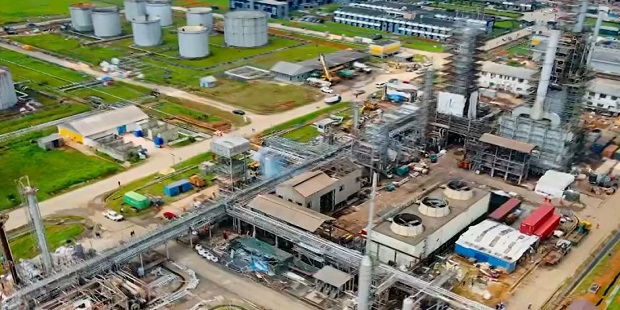Nigerian independent Green Energy International Limited (GEIL) has reached a significant milestone with the mechanical completion of its 750,000-barrel crude oil capacity onshore terminal, which is now entering the commissioning phase. This development follows approval from the Nigerian Upstream Petroleum Regulatory Commission (NUPRC) to introduce crude into the facility, located in Otakikpo in eastern Nigeria.
On March 28, 2025, the regulator dispatched four separate letters to the company, granting various approvals. The primary authorization covered the commissioning and hydrocarbon introduction to the main Otakikpo 750,000 barrels onshore terminal facility. This comprehensive approval encompasses multiple components, including four 125,000-barrel crude oil storage tanks, a slop tank complete with associated pumps and transfer systems, firefighting and nitrogen systems, terminal control and power supply infrastructure, and various terminal buildings with ancillary facilities such as control rooms, administrative offices, and accommodation structures.
Additional approvals from the NUPRC included authorization for hydrocarbon introduction into the 8-inch by 2-kilometer crude evacuation pipeline connecting the permanent Early Production Facility (EPF) node to the onshore inlet manifold node. The regulator also approved the introduction of hydrocarbon into the 4-inch by 2-kilometer fuel gas pipeline running from the Central Processing Facility (CPF) node to the onshore node, along with produced water to the flowstation node. Finally, approval was granted for commissioning and hydrocarbon introduction into the 4-inch by 2-kilometer produced water pipeline connecting the onshore Terminal node to the Flowstation Node.
Upon completion of the commissioning process, the Otakikpo Terminal will join an elite group of operational terminals in Nigeria, including the Renaissance (formerly Shell) operated Bonny and Forcados Terminals, the Chevron operated Escravos Terminal, the Oando (formerly ENI) operated Brass Terminal, the TOTALEnergies operated Odudu Terminal, and the Qua Iboe Terminal (formerly operated by ExxonMobil, now by Seplat). These terminals serve both asset operators and third-party oil producers. GEIL management takes particular pride in highlighting that while these other terminals were originally constructed by International Oil Companies—though now mostly operated by Nigerian independents—the Otakikpo terminal represents the first onshore facility of its kind built entirely by a homegrown Nigerian firm.
Beyond serving GEIL’s own production needs and those of its partner Lekoil, the Otakikpo Terminal offers a compelling proposition for operators in the eastern Niger Delta region. These producers would otherwise need to transport their crude through lengthy pipelines vulnerable to vandalism en route to existing terminals, making the new facility an attractive alternative.
The project’s foundation was laid in October 2023, with CAKASA, the EPC engineering firm, overseeing numerous subcontractors responsible for constructing accommodation and administrative facilities for 120 personnel, installing tanks, Lease Automatic Custody Transfer (LACT) Units for oil sampling and measurement during company transfers, pumps, generators, and other essential equipment.
The terminal design allows for future expansion to a handling capacity of 1.5 million barrels of crude. A standout feature of the facility is its 23-kilometer pipeline extending into the Atlantic Ocean, facilitating the berthing and loading of export tankers, as explained by Kayode Adejulugbe, GEIL’s Chief Operating Officer (COO). This setup enables companies to pump their crude oil into the terminal for subsequent export through the pipeline.
The offshore components, crucial for transferring crude from the terminal to vessels in the Atlantic Ocean for export, include a Pipe Line End Manifold (PLEM)—a subsea structure serving as a connection point between main and branch pipelines—and a buoy system.
According to GEIL’s COO, the terminal and export infrastructure align with the company’s strategy to develop an efficient evacuation and export system at Otakikpo, thereby reducing overall operational expenses per barrel. The company also intends to transform the Otakikpo field into a crude processing and export hub by providing access to purpose-built evacuation and export infrastructure for numerous stranded fields in the Eastern Niger Delta area. More than 20 stranded fields in close proximity to the terminal stand to benefit from this readily accessible and cost-effective route to market.
The terminal represents a key component of what GEIL’s COO has termed “the Green Energy 2026 Story,” which he acknowledges would not have been possible without the exceptional contributions of several Nigerian organizations. He specifically highlights Fidelity Bank’s role in supporting the company by structuring a $250 million loan for both phases of their project—covering both the terminal and an earlier two-well drilling and completion campaign—in the remarkably short timeframe of less than eight months, a feat he describes as “most unprecedented.”
Source: africaoilgasreport.com
